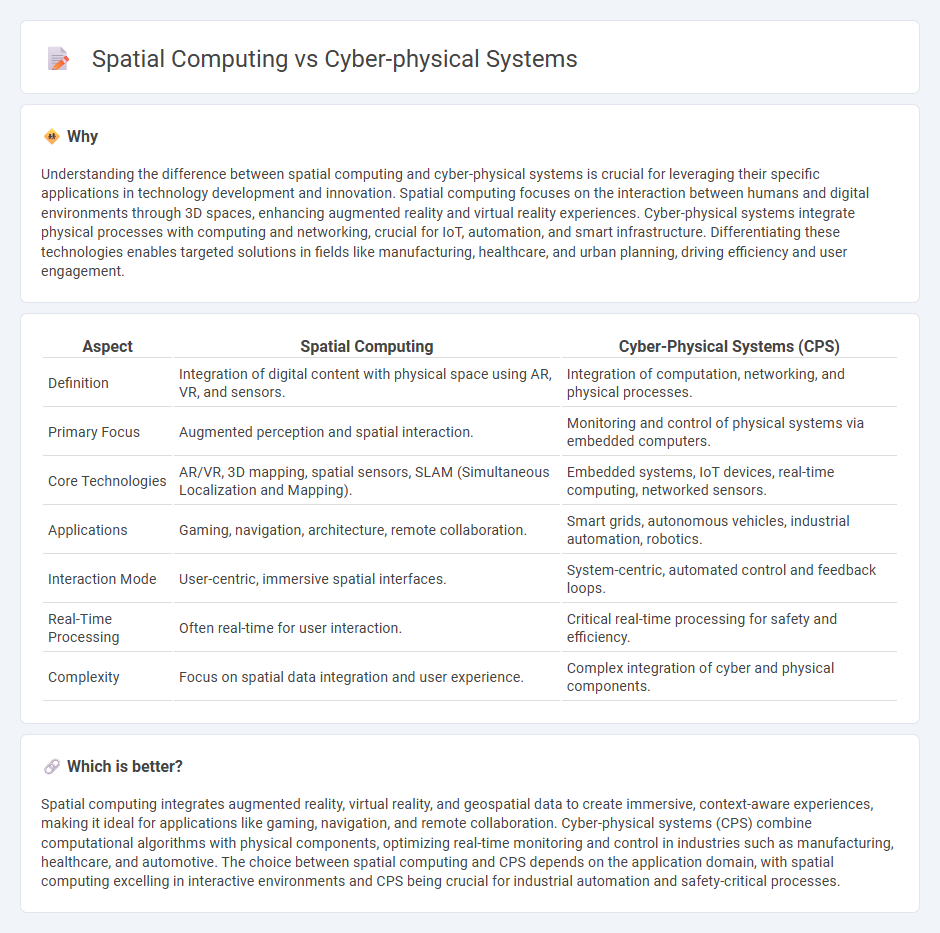
Spatial computing integrates digital information with physical spaces through advanced sensors and augmented reality, enabling immersive and interactive user experiences. Cyber-physical systems combine computational algorithms with physical processes, utilizing embedded sensors and control systems to monitor and manage complex environments like smart grids or autonomous vehicles. Explore the distinct applications and innovations driving the future of these transformative technologies.
Why it is important
Understanding the difference between spatial computing and cyber-physical systems is crucial for leveraging their specific applications in technology development and innovation. Spatial computing focuses on the interaction between humans and digital environments through 3D spaces, enhancing augmented reality and virtual reality experiences. Cyber-physical systems integrate physical processes with computing and networking, crucial for IoT, automation, and smart infrastructure. Differentiating these technologies enables targeted solutions in fields like manufacturing, healthcare, and urban planning, driving efficiency and user engagement.
Comparison Table
| Aspect | Spatial Computing | Cyber-Physical Systems (CPS) |
|---|---|---|
| Definition | Integration of digital content with physical space using AR, VR, and sensors. | Integration of computation, networking, and physical processes. |
| Primary Focus | Augmented perception and spatial interaction. | Monitoring and control of physical systems via embedded computers. |
| Core Technologies | AR/VR, 3D mapping, spatial sensors, SLAM (Simultaneous Localization and Mapping). | Embedded systems, IoT devices, real-time computing, networked sensors. |
| Applications | Gaming, navigation, architecture, remote collaboration. | Smart grids, autonomous vehicles, industrial automation, robotics. |
| Interaction Mode | User-centric, immersive spatial interfaces. | System-centric, automated control and feedback loops. |
| Real-Time Processing | Often real-time for user interaction. | Critical real-time processing for safety and efficiency. |
| Complexity | Focus on spatial data integration and user experience. | Complex integration of cyber and physical components. |
Which is better?
Spatial computing integrates augmented reality, virtual reality, and geospatial data to create immersive, context-aware experiences, making it ideal for applications like gaming, navigation, and remote collaboration. Cyber-physical systems (CPS) combine computational algorithms with physical components, optimizing real-time monitoring and control in industries such as manufacturing, healthcare, and automotive. The choice between spatial computing and CPS depends on the application domain, with spatial computing excelling in interactive environments and CPS being crucial for industrial automation and safety-critical processes.
Connection
Spatial computing integrates digital and physical environments by leveraging sensing, mapping, and interaction technologies to create immersive user experiences. Cyber-physical systems (CPS) combine computation, networking, and physical processes, enabling real-time monitoring and control of physical entities through embedded sensors and actuators. The connection lies in spatial computing providing contextual, location-based data crucial for CPS to perform dynamic decision-making and adaptive control in smart environments, industrial automation, and autonomous systems.
Key Terms
**Cyber-physical systems:**
Cyber-physical systems integrate computational algorithms with physical processes, enabling real-time monitoring, control, and automation across industries such as manufacturing, healthcare, and transportation. These systems rely on sensors, actuators, and connected devices to create a seamless interface between the digital and physical worlds, enhancing efficiency and safety. Explore more to understand how cyber-physical systems drive innovation in smart infrastructure and autonomous systems.
Sensors and Actuators
Cyber-physical systems integrate sensors and actuators to monitor and control physical processes in real time, enabling precise interaction between digital and physical components. Spatial computing leverages advanced sensors, such as LIDAR and depth cameras, alongside actuators to create immersive, location-aware environments that respond dynamically to user interactions. Explore how these technologies transform industries by enhancing automation, accuracy, and user experience.
Embedded Systems
Cyber-physical systems (CPS) integrate embedded systems with physical processes, enabling real-time monitoring and control through sensors, actuators, and networking technologies. Spatial computing leverages embedded systems to create immersive environments by combining physical space with digital data for enhanced interaction and context-awareness. Explore in-depth how embedded systems drive innovation in both CPS and spatial computing applications.
Source and External Links
Cyber-Physical Systems (CPS) Explained - Splunk - Cyber-physical systems integrate sensing, computation, control, and networking into physical objects and infrastructure, connecting them to the Internet and enabling the digital simulation and automation of physical processes.
Cyber-Physical Systems - a Concept Map - UC Berkeley - CPS are engineered systems where embedded computers and networks continuously monitor and control physical processes, with feedback loops between the physical and computational components.
10 Examples of Cyber-Physical Systems - Claroty - CPS are platforms that tightly integrate computation, control, networking, and analytics with the physical environment and users, enabling advanced automation in industries like manufacturing and healthcare, and differ from IoT by emphasizing real-time physical process integration and control.
 dowidth.com
dowidth.com